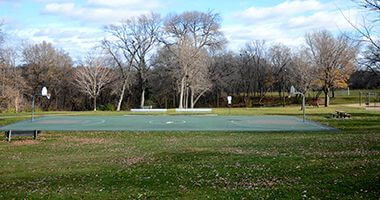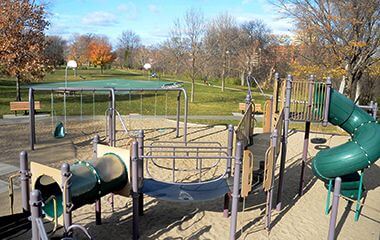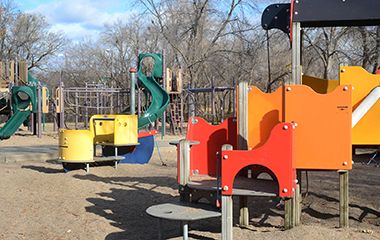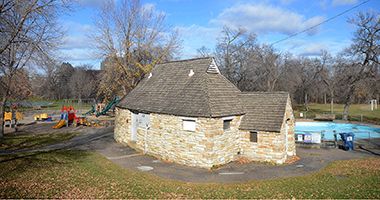Address
2820 S Eighth St.
Minneapolis, MN 55454
Plan Your Route
Contact
Phone: 612-230-6400
Email: info@minneapolisparks.org
Park Hours
6 am-midnight in developed areas
6 am-10 pm in undeveloped areas
Ordinance PB-2-33
Wading Pool Information
Riverside Park
Part of: Mississippi Gorge Regional Park
Nearby Recreation Center: Matthews Recreation Center
Features & Amenities
- Basketball Court
- Drinking Fountain
- Grill
- Picnic Area
- Playground/Tot Lot
- Restroom Facility
- Soccer Field
- Softball Field
- Volleyball Court
- Wading Pool
- Walking Path
Good to Know
Nearby Dog Park: Franklin Terrace Dog Park
Park Projects
See what’s currently in the works for this park. Some projects may be under the name of the regional park or service area it lives within. View Current Projects
Park Details
At first glance the park appears to be a quiet, typical neighborhood park. Given a closer look, though, the park reveals complex layers of historical and natural interest.
Rentals & Permits
Outdoor Use and Event Space: Learn how to reserve park space for corporate events, community celebrations, and more.
History
Name: The park was named in 1885 for its location near the Mississippi River. Until then the park was referred to as Sixth Ward Park
Acquisition and Development
Land for Riverside Park was among the first designated for a park by the park board shortly after its creation in April 1883. Wrangling over the exact shape and size of the park, and objections from property owners, pushed back the acquisition to 1884 when nearly 20 acres were acquired for a little less than $60,000. From the time the park was acquired, it was intended to be the northern anchor for a parkway that would extend downriver eventually to Minnehaha Creek and Fort Snelling.
A major expansion of the park occurred in 1911 when another 22.5 acres were added to the southern end of the park at a cost of about $50,000. The board decided to acquire the additional land adjacent to Riverside Park in part to extend its riverside holdings but also to forestall the operation of a dance hall adjacent to the park. When the park board learned of plans to build a dance hall next to the park, it acted to purchase and condemn the land for a larger park.
The original plan for Riverside Park was created by landscape Horace Cleveland, who had included the park in his 1883 “suggestions” for a system of parks and parkways for the city. Cleveland loved the river banks and even suggested that Riverside Park might be connected by a bridge to the east river flats, which he also thought should be acquired as a park. Cleveland commented on his original plan for the park that “the paths are few—the intention being that visitors should ramble at will in the woods and on the lawns.” Cleveland’s plans were implemented in the park in 1885.
While supervising improvement of the park that year, park board president Charles Loring took offense at some criticism of the work by other commissioners and promptly resigned from the park board. Other commissioners and newspapers around Minnesota urged Loring to reconsider, which he did. He returned to the park board after an absence of a couple months.
In 1890 a road was built from the upper portion of the park to a concourse about half way down the bluff and stairs were built from this concourse to the wooded tract along the river.
Riverside Park was viewed by the park board as one of the best places in the park system for active recreation. A toboggan slide was built on the steep slopes in the winter of 1887. In 1904, the park board approved the first installation of children’s play equipment in any park—swings, teeter-totters and sandboxes—at Loring and Riverside parks for the spring of 1905. When the next year the park board decided to install more extensive playground and gymnastic apparatus in parks, it chose Riverside Park and Logan Park. The first toilet at Riverside Park was built in 1905. By 1908, when the first basketball goals were put in city parks, including a set at Riverside Park, Riverside had the largest playground attendance in the city.
The popularity of Riverside Park led park superintendent Theodore Wirth to propose an ambitious new plan for the park in 1913. The plan included an outdoor amphitheater and a combined football and baseball field. In the absence of further improvements at Riverside, Wirth submitted new plans for the park in 1916, which would have divided the park into four terraces and provided a grandstand for the athletic fields that overlooked the river, and a fieldhouse. The last traces of the old quarry that had occupied the site when it was acquired were removed in 1919, when the site was graded. Wirth advised that the grading would allow the installation of tennis courts on the north end of the park in 1920.
Wirth tried again in 1925 to persuade the board to improve the park further with plans for an outdoor concert theater overlooking the river. Wirth later surmised that his plans were never carried out because after the construction of the Ford Dam in 1917, the river became a reservoir that was in fact nearly a cesspool and gave off an unbearable odor. Much of the city’s raw sewage flowed into the river until the 1930s.
Despite many grand plans for the park, the board finally gave Riverside a warming house in 1927 for its skating rink. In 1932 it added two tennis courts, a wading pool and new toilets.
During the 1930s, considerable work was done by the WPA around Riverside Park, including construction of the stone steps leading from the upper level of the park to the lower level. In 1933 a stone bathhouse was also built.
Riverside Park reached its current size in 1962, when less than two acres were taken for the construction of I-94, for which the highway department paid $275,000, and the park was regraded and rearranged to accommodate the freeway.
Extensive improvements at Riverside Park were begun in 2000, when the upper level of the park was refurbished with new playground equipment, seating and picnic tables. The basketball court was replaced with the help of a $10,000 grant from the Minnesota Timberwolves. The soccer field was also upgraded, but soccer goals were not erected at the time, in part to keep the space open for multiple uses.
Riverside Park became one of the first parks in the city with space dedicated to dogs, when 1.28 acres of the park were fenced in and designated as an “off-leash recreation area” in 2001.
In 2018 the section of the park closest to the river, previously called Lower Riverside Park, was renamed Annie Young Meadow in honor of the seven-term commissioner who passed away earlier that year.
Park history compiled and written by David C. Smith.











